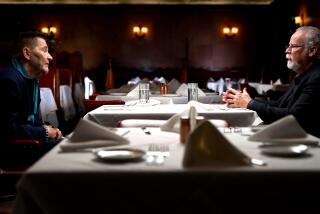THE O.J. SIMPSON MURDER TRIAL : A Photo Shatters His Professional Armor
- Share via
Reporters shield themselves from emotion with detail--note-taking, schedules and the other arrangements of covering a story.
They wrap themselves in a cocoon of impersonality as protection against the personal and professional tragedies they cover and sometimes cause by the revelations in their stories. Their habit is not unusual. Detachment is a refuge for surgeons, cops, lawyers and others whose work involves tragedy.
Thus the journalists moved arrangements to the top of the agenda last week when they began preparing for one of their most wrenching jobs in the O.J. Simpson murder trial--viewing the autopsy pictures of Nicole Brown Simpson and Ronald Goldman.
*
The issue at the outset was how many reporters would be permitted to see 58 photographs of the murder victims taken at the death scene and in the morgue. The photographs, showing bloody, deep and gaping wounds, were presented to the jury last week by the district attorney’s office to illustrate the brutality of what prosecutors allege was Simpson’s premeditated assault.
The press wanted to see them too, not out of morbid curiosity but because we don’t believe defendants should be convicted or acquitted on secret evidence. If the prosecution says it was a savage attack, the press and the public should know just how savage it was.
Prosecutor Brian Kelberg argued against the press. Let the reporters write their accounts from the prosecution’s written summaries of the photographs, he said.
Judge Lance A. Ito’s first inclination was to side with Kelberg. “The victims should be allowed some final shred of dignity rather than having their earthly remains publicly displayed in their savaged and pathetic state,” he wrote in a judicial order. But, he said, the free press provisions of the U.S. Constitution guarantee the press’s right to view evidence. He ordered “limited public access to the autopsy photos.”
At first, this meant six, just a small number of the 48 news organizations and individual writers who are covering the trial. The reporters objected. There was no fair way to pick the six or to be sure of their competence. Everyone should have a chance. Ito relented and raised the number to 24, the number of courtroom seats allocated to reporters.
That still wasn’t enough. The press threw itself into the arrangements’ dispute. Reporters talked of protests to Judge Ito and to his press spokesperson, Jerrianne Hayslett. Criticism of the judge, already sharpened by his strict courtroom deportment rules, intensified.
As the press raged, Hayslett got together with Nina Goebert, who coordinates the Radio-Television News Assn. of Southern California pooled broadcast organizations. She coordinates the Court TV courtroom broadcasts and those from other sites in the Criminal Courts Building.
Goebert, a veteran of CBS and CNN, had in the past been in charge of major events requiring pool coverage, including the first trial of the cops who beat Rodney King and the 1986 international economic summit in Venice. She knew how to make the press happy. With Hayslett, they figured out how to expand the pool to 48. The judge agreed, and the arrangements were made.
By Monday morning, there was nothing to think about but seeing the pictures.
*
We gathered in the hallway outside the courtroom. I felt nervous.
I hadn’t expected to be admitted to see the pictures. Our paper had just one pass, and it was used by staffer Andrea Ford. But some reporters didn’t show up, and Hayslett admitted me to the courtroom where the photographs were displayed.
I looked at all the pictures, but only one held me captive. It was a full face shot of Nicole Brown Simpson, her neck slashed so deeply that her vertebrae are visible at the end of a gaping cavity of flesh.
My eyes moved upward to her face. It was a beautiful, delicate face and, at least to me, seemed to have the quality of reflecting her last emotions, of calling out beyond the grave. Her eyes were half opened. Her mouth was turned downward. A slight bruise discolored the skin at the left side of the mouth. She looked pained and sad.
Maybe it’s my own emotions, my own preoccupation with family, but I thought I saw her thinking, in her last moments, of the two children she’d never see again and her own life, cut off when she was so young.
*
After the viewing, I wondered whether viewing such pictures would affect our coverage in the remaining months of the trial.
I’m sure many of my colleagues would say no. We just report the facts. As for me, the morning reminded me of something I knew, but had put to the back of my mind while occupied with the trivia of the trial. This is not a show. It is not an amusement. It is a terrible human tragedy.
More to Read
Sign up for Essential California
The most important California stories and recommendations in your inbox every morning.
You may occasionally receive promotional content from the Los Angeles Times.












